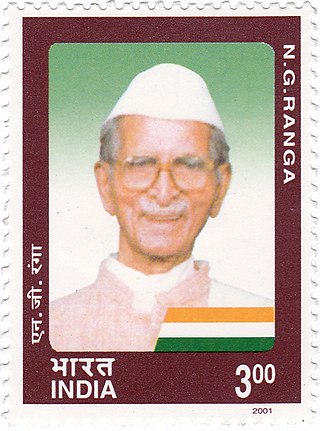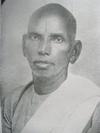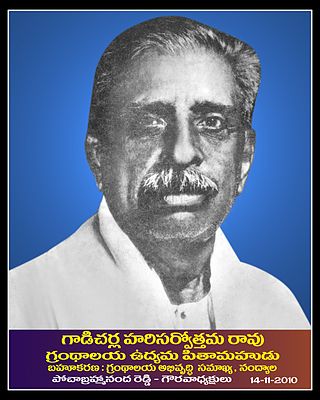Related Research Articles
Kamma is a Hindu caste from South India. The community of Kammas is believed to have originated from agriculturists of the Kammanadu region of the erstwhile Guntur district and Ongole division in Andhra Pradesh. Propelled by their military activity in the Vijayanagara Empire, Kammas are believed to have spread out from the region during the Vijayanagara period, followed by some in-migration during the British period and out-migration again during the twentieth century. Today they are regarded as the richest group in Andhra Pradesh and are a dominant caste from Coastal Andhra with socio-economic and political prominence throughout the Telugu-speaking regions of India.

Coastal Andhra or Kostandhra is a geographic region in the Indian state of Andhra Pradesh. Vijayawada is the largest city in this region. Region share borders with Uttarandhra, Rayalaseema and Telangana. It was part of Madras State before 1953 and Andhra State from 1953 to 1956. According to the 2011 census, it has an area of 91,915 square kilometres (35,489 sq mi) which is 57.99% of the total state area and a population of 34,193,868 which is 69.20% of Andhra Pradesh state population. This area includes the coastal districts of Andhra Pradesh on the Circar Coast between the Eastern Ghats and the Bay of Bengal, from the northern border with Odisha to Rayalaseema in the south.

Rayalaseema is a geographic region in the Indian state of Andhra Pradesh. It comprises four southern districts of the State, from prior to the districts reorganisation in 2022, namely Kurnool, Anantapur, YSR and Chittoor. Four new districts were created from these, namely Sri Sathya Sai, Nandyal, Annamayya and Tirupati. As of 2011 census of India, the western four districts of the region had a population of 15,184,908 and cover an area of 71,060 km2 (27,440 sq mi).
Krishikar Lok Party was a political party in the Hyderabad State, India, which existed from April to June 1951. The KLP was formed when Acharya N. G. Ranga separated from the Hyderabad State Praja Party.

Potti Sreeramulu, was an Indian freedom fighter and revolutionary. Sreeramulu is revered as Amarajeevi in the Andhra region for his self-sacrifice for the Andhra cause. He became famous for undertaking a hunger strike for 56 days in support of having separate state for Andhra Pradesh; he died in the process. His death sparked public rioting and Indian Prime Minister Jawaharlal Nehru declared the intent by the newly liberated nation to form Andhra State three days following the death of Sreeramulu. He contributed his life for the formation of a separate Telugu-speaking state from the dominant Tamil-speaking Madras presidency. His struggles led to the formation of separate Telugu-speaking state called "Andhra state".
Bapatla is a city and district headquarters of Bapatla district in the Indian state of Andhra Pradesh. It is a municipality and the mandal headquarters of Bapatla mandal of Bapatla revenue division. The nearest towns and cities to Bapatla are Chirala, Ponnur, Tenali and Guntur of 17 km, 22 km, 50 km and 53 km respectively.
Kapu is a Hindu caste mainly found in the Indian state of Andhra Pradesh. They are classified as a Forward caste. They are a community of land-owning agriculturists. Historically, they have also been warriors and military generals (Nayakas) in Hindu armies. They are a dominant caste of Andhra Pradesh. Kapus commonly carry the title Naidu. They are primarily present in Coastal Andhra with major concentration in the Godavari-Krishna delta region.

Sardar Gouthu Latchanna was a veteran freedom fighter from India.

Acharya Gogineni Ranga Nayukulu, also known as N. G. Ranga, was an Indian freedom fighter, classical liberal, parliamentarian and farmers' leader. He was the founding president of the Swatantra Party, and an exponent of the peasant philosophy. He received the Padma Vibhushan award for his contributions to the Peasant Movement. N.G. Ranga served in the Indian Parliament for six decades, from 1930 to 1991.
Telaga is a community found in Coastal Andhra region of India. Telaga is a subcaste of Kapu and both terms are often used synonymously. They are classified as a Forward caste. They are a land-owning agrarian community. Historically, they were a warrior caste known for their honour and bravery.
Settibalija refers to two distinct and completely unrelated communities in Andhra Pradesh, India. The term Setti Balija historically referred to a sub-caste of the Balija community. These Setti Balijas were a prominent mercantile community of South India with a history dating back to the Vijayanagara Empire. They are currently found in the Rayalaseema region and are classified as a Forward Caste.
Nandivada is a village in Krishna district of the Indian state of Andhra Pradesh. It is located in Nandivada mandal of Gudivada revenue division. It is one of the villages in the mandal to be a part of Andhra Pradesh Capital Region. Geographically, it is 8 kilometres north of Gudivada and directly adjacent to the town of Sreenivasapuram.
The Tsundur Massacre refers to the killing of several Dalit people in the village of Tsundur, Guntur district, Andhra Pradesh, India, on 6 August 1991. 8 Dalits were massacred by Reddy men with the alleged help of the police. When a young graduate Dalit youth was beaten because his feet unintentionally touched a Reddy woman near a cinema hall, the Dalits of the village supported him. As a result, Dalits were socially boycotted by the Reddy landowners of the village. Many Dalits have lost their livelihood as they depend on the daily wages by working in the paddy fields of the Reddys. The significance of this atrocity was Dalits collectively fought to gain legal justice by invoking SC/ST Prevention of Atrocities Act 1989.
Gottipati Brahmayya was a freedom fighter, popularly known as Ryotu Pedda. He was awarded the Padma Bhushan in 1982.

Kalluri Chandramouli was an Indian politician and independence activist from the state of Andhra Pradesh, South India.He held ministerial posts in three states: Madras State, Andhra State and Andhra Pradesh. Served as the Minister of Endowments and as the President of the Board of Trustees of Tirumala Tirupati Devasthanam. He renovated Srisailam and Bhadrachalam temples.
Sribagh Pact is an agreement between the political leaders of Coastal Andhra and Rayalaseema regions during the separate Andhra on 16 November 1937. Historically, the Sribagh Agreement has been an important subject matter to the people of the Rayalaseema region regarding developmental issues due to the attitude of the then-Andhra leaders.

Konda Venkatappayya or Konda Venkatappaiah B.L. (1866–1948) was a noted Indian lawyer, freedom fighter, and politician from what is now Andhra Pradesh. He was one of the founders and the first editor of Krishna Patrika, a leading weekly Telugu magazine during the early 20th century.

Gadicherla Harisarvottama Rao was a freedom fighter from Andhra during the Indian independence movement. He was inspired by the ideologies of Bal Gangadhar Tilak and Bipin Chandra Pal and joined the freedom movement at a very young age. He is the person who named the region as Rayalaseema when everybody taunted the region as Ceded because Nizam ceded the region to the British.

Paturi Nagabhushanam was described as the doyen of the Andhra Library Movement from Andhra Pradesh, India. Paturi was associated with the national independence movement and an ardent follower of Gandhiji. His contributions are noteworthy - in spreading library movement in the state of Andhra Pradesh among the public, strengthening Andhra Pradesh Library Association propagating adult literacy, the establishment of library school for imparting training to library workers and giving library education under State government certification and publishing books, periodicals, LIS textbooks. He is the founder of Sarvottama Granthalayam in Vijayawada.
References
- 1 2 N. G. Ranga (1976). Distinguished Acquaintances, Vol 1. Desi Book Distributors. p. 43.
- ↑ B. Suguna (2009). Women's Movement. Discovery Publishing House. ISBN 9788183564250.
- ↑ Malladi Subbamma (1994). Women and Social Reform. Booklinks Corporation. p. 79.
- 1 2 3 "Bharati Devi Gogineni". amritmahotsav.nic.in.
- ↑ M. A. Nayeem (2000). History of Modern Deccan, 1720/1724-1948: Political and administrative aspects. Abul Kalam Azad Oriental Research Institute. p. 221.
- ↑ Pagadala, Tejaswini (2018). India's Glocal Leader Chandrababu Naidu. Bloomsbury Publishing. ISBN 9789387146600.